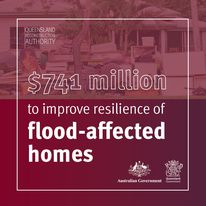Queensland Resilient Homes Fund
The Resilient Homes Fund includes three funding programs to improve Queenslander’s residences’ resilience to flooding through resilient retrofit, home raising, or voluntary buy-back programs.
Description
The $741M Resilient Homes Fund (RHF) is jointly funded by the Queensland and Australian Governments. The program is available across 39 local government areas to homeowners impacted by the 2021-2022 floods. The package includes three funding programs to improve Queenslander’s residences’ resilience to flooding through resilient retrofit, home raising, or voluntary buy-back programs.
The Resilient Retrofit Program provides funding to repair (enhancing resilience) or retrofit homes to incorporate flood resilient design and materials in liveable rooms or areas, and to raise or relocate services essential to the continued liveability of the home. Grants of up to $50,000 are available to eligible homeowners.
The Home Raising Program provides a grant to raise the home to reduce the impacts of future flood events. The focus is on raising habitable floors to meet or exceed the required flood hazard level (minimum habitable floor level), as prescribed by the relevant local government planning scheme. This initiative may also include moving the home on the same parcel of land (for example, moving it to higher ground). Grants of up to $100,000 are available to eligible homeowners .
The Voluntary Home Buy-Back Program provides funding for eligible local governments to buy back flood affected homes on a voluntary basis. The buyback of homes will be considered on a case-by-case basis, with land to be rezoned to prevent buildings being built on the land in the future. It is expected the program will purchase of around 500 homes.
The Queensland Reconstruction Authority is administering the voluntary home buy back program, with the Department of Energy and Public Works administering the resilient retrofit and home raising program.
Did the Sendai Framework change or contribute to changes in your activities/organization? If so, how?
The Queensland Reconstruction Authority (QRA) is the state’s lead agency responsible for disaster recovery and resilience policy in Queensland. Under this remit, QRA has developed the Queensland Strategy for Disaster Resilience (QSDR) which is aligned to the Sendai Framework. The QSDR advocates for opportunities to build resilience across Queensland, as well as provides linkages to effective resilience building in preparedness and recovery activities at the national and international level.
What led you to make this commitment/initiative?
What was your position before making this Voluntary Commitment / prior to the Sendai Framework?
The Queensland Government is committed to demonstrating our approach to strengthening disaster resilience to ensure communities are better equipped to deal with the increasing prevalence of natural disasters. QRA hopes that by making this commitment, we can share our learnings and progress with the international community to assist in developing similar programs in their context.

